Merge Sort Explained: Step-by-Step Guide for Beginners
 Keerthi Ravilla Subramanyam
Keerthi Ravilla Subramanyam
Previously, we explored Bubble Sort, Selection Sort, and Insertion Sort—basic sorting algorithms that help beginners understand sorting concepts. However, as we discussed, Bubble Sort struggles with large datasets, and both Selection and Insertion Sort have notable drawbacks due to their time complexity of O(n²), making them inefficient for larger datasets. Now, let’s dive into Merge Sort, a more efficient sorting algorithm with a time complexity of O(n log n). In this article, you will find a detailed explanation of Merge Sort and its algorithm, presented step-by-step with clear examples to make it easy for beginners to follow.
What is Merge Sort?
Merge Sort is a divide-and-conquer algorithm. It breaks a problem into smaller sub-problems, solves them independently, and combines the results. The core idea behind Merge Sort is to divide an array into halves, sort each half, and merge the sorted halves back together.
Unlike Bubble Sort, which repeatedly swaps adjacent elements, Merge Sort takes a more structured approach by dividing the array into manageable pieces and sorting those pieces before combining them.
How Merge Sort Works (Step-by-Step Breakdown)
Let's walk through an example to understand how Merge Sort works in practice.
Example:
Imagine we have the following array to sort:
[38, 27, 43, 10]
Step 1: Divide the Array
The first step is to repeatedly divide the array into two halves until each sub-array contains only one element.
Initial Split:
Split
[38, 27, 43, 10]into two halves:Left half: [38, 27] Right half: [43, 10]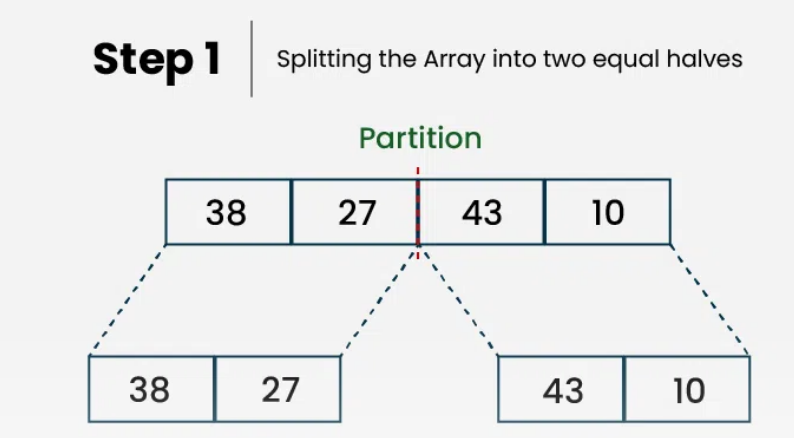
Further Split:
Split
[38, 27]into:Left half: [38] Right half: [27]Split
[43, 10]intoLeft half: [43] Right half: [10]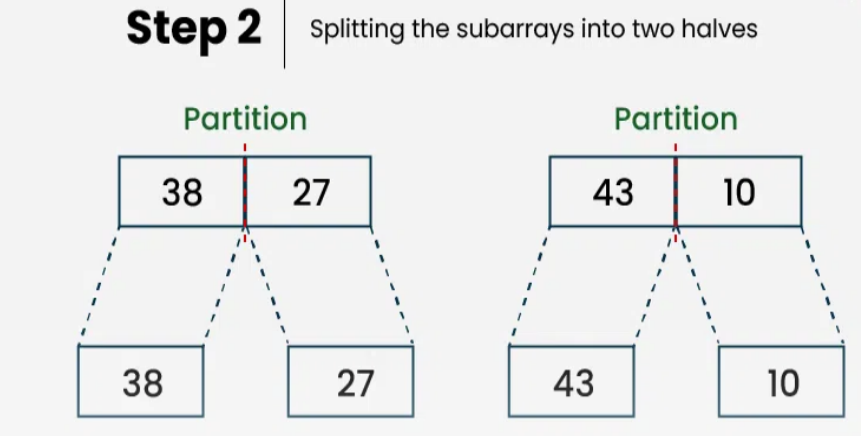
At this point, the array is broken down into individual elements:
[38], [27], [43], [10]
Step 2: Merge the Sub-arrays
Now that we have single-element sub-arrays, we start merging them back together in sorted order.
Merging
[38]and[27]:Compare
38with27. Since27is smaller, it comes first.The merged result is:
[27, 38]
Merging
[43]and[10]:Compare
43with10. Since10is smaller, it comes first.The merged result is:
[10, 43]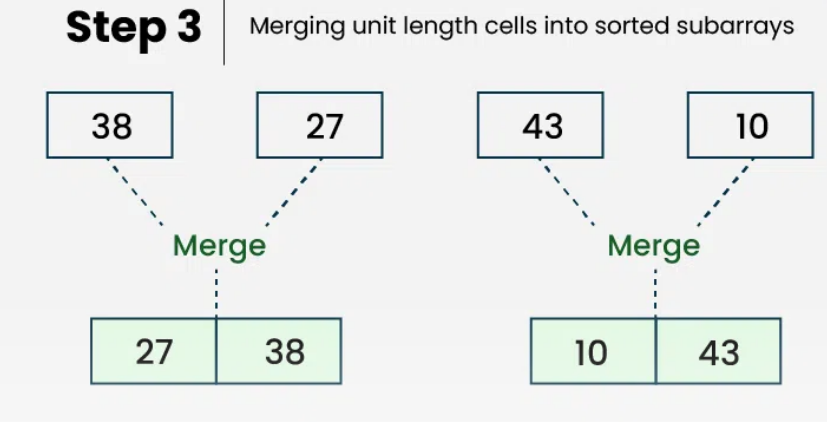
Step 3: Final Merge
Now we merge the two sorted halves [27, 38] and [10, 43]:
Compare
27with10. Since10is smaller, it comes first.Compare
27with43. Since27is smaller, it comes next.Compare
38with43. Since38is smaller, it comes next.Finally, add
43as it’s the last remaining element.
The final sorted array is:
[10, 27, 38, 43]
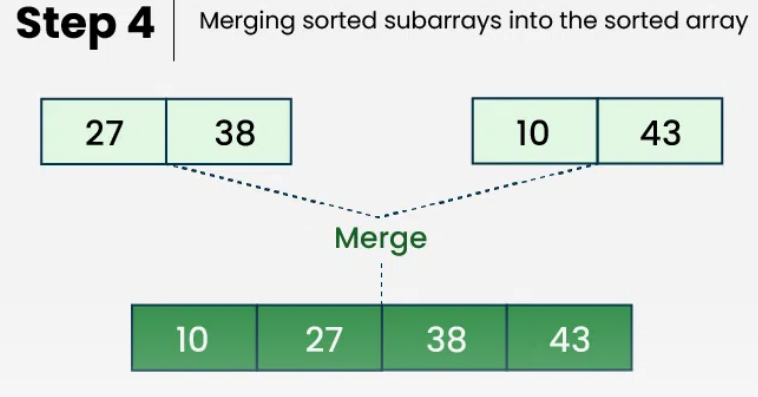
Pseudocode for the Merge Sort algorithm
Steps for Merge Sort:
Define the Function:
- Create a function called
mergeSortthat takes an array as input.
- Create a function called
Base Case:
Check if the length of the array is less than or equal to 1.
- If true, return the array (it is already sorted)
Divide the Array:
Calculate the middle index of the array by dividing its length by 2.
Create two sub-arrays:
left_halfcontains elements from the start of the array to the middle index.right_halfcontains elements from the middle index to the end of the array.
Recursively Sort:
Recursively call
mergeSorton theleft_halfand store the sorted result inleft_sorted.Recursively call
mergeSorton theright_halfand store the sorted result inright_sorted.
Merge the Sorted Halves:
Create a function called
mergethat takesleft_sortedandright_sortedas inputs.Initialize an empty array called
result.Set two pointers,
iandj, to 0 (for theleft_sortedandright_sortedarrays, respectively).
Comparison and Merging:
While both pointers
iandjare within the bounds of their respective arrays:Compare
left_sorted[i]andright_sorted[j].If
left_sorted[i]is less than or equal toright_sorted[j]:Append
left_sorted[i]toresult.Increment pointer
i.
Otherwise:
Append
right_sorted[j]toresult.Increment pointer
j.
Add Remaining Elements:
After the comparison loop, if there are remaining elements in
left_sorted, append them toresult.If there are remaining elements in
right_sorted, append them toresult.
Return the Merged Result:
- Return the
resultarray, which contains the merged and sorted elements.
- Return the
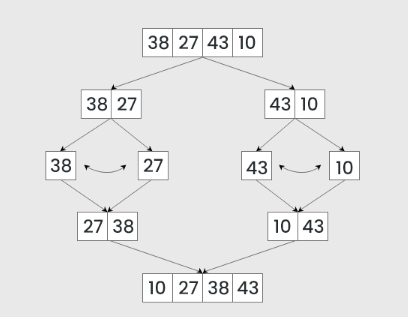
Python Code for Merge Sort
Here’s how the Merge Sort algorithm is implemented in Python. This code follows the same steps we outlined above:
def merge_sort(arr):
# Base case: if the array has 1 or 0 elements, it's already sorted
if len(arr) <= 1:
return arr
# Find the middle point and divide the array into two halves
mid = len(arr) // 2
left_half = arr[:mid]
right_half = arr[mid:]
# Recursively sort both halves
left_sorted = merge_sort(left_half)
right_sorted = merge_sort(right_half)
# Merge the sorted halves
return merge(left_sorted, right_sorted)
def merge(left, right):
sorted_array = []
i = j = 0
# Compare elements from both halves and merge them in sorted order
while i < len(left) and j < len(right):
if left[i] < right[j]:
sorted_array.append(left[i])
i += 1
else:
sorted_array.append(right[j])
j += 1
# If there are remaining elements in the left half, add them
while i < len(left):
sorted_array.append(left[i])
i += 1
# If there are remaining elements in the right half, add them
while j < len(right):
sorted_array.append(right[j])
j += 1
return sorted_array
# Example usage
arr = [38, 27, 43, 10]
sorted_arr = merge_sort(arr)
print(sorted_arr) # Output: [10, 27, 38, 43]
Why is Merge Sort Efficient?
The key to Merge Sort's efficiency is its O(n log n) time complexity. This is due to the way it repeatedly divides the array in half (log n steps) and then merges each half back together in linear time (n steps). Unlike algorithms like Bubble Sort, which has a time complexity of O(n²) and becomes inefficient for larger datasets, Merge Sort ensures steady performance, even in worst-case scenarios.
Conclusion
In our previous discussions, we introduced the basics of sorting. Now, with Merge Sort, we've stepped into more advanced sorting techniques, gaining an understanding of how divide-and-conquer approaches can significantly improve efficiency. By breaking the array down into smaller parts, sorting them individually, and then merging them back together, Merge Sort provides a powerful tool for handling larger datasets.
Merge Sort is an important algorithm for both beginners and experienced developers alike. As you practice, you’ll find its methodical approach easy to understand and implement. Stay tuned for more insights on sorting algorithms and data structures as we continue this journey through the fundamentals of computer science!
Subscribe to my newsletter
Read articles from Keerthi Ravilla Subramanyam directly inside your inbox. Subscribe to the newsletter, and don't miss out.
Written by

Keerthi Ravilla Subramanyam
Keerthi Ravilla Subramanyam
Hi, I'm Keerthi Ravilla Subramanyam, a passionate tech enthusiast with a Master's in Computer Science. I love diving deep into topics like Data Structures, Algorithms, and Machine Learning. With a background in cloud engineering and experience working with AWS and Python, I enjoy solving complex problems and sharing what I learn along the way. On this blog, you’ll find articles focused on breaking down DSA concepts, exploring AI, and practical coding tips for aspiring developers. I’m also on a journey to apply my skills in real-world projects like predictive maintenance and data analysis. Follow along for insightful discussions, tutorials, and code snippets to sharpen your technical skills.